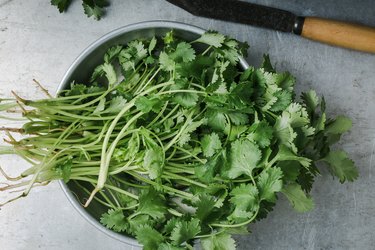
Cilantro enhances all kinds of dishes, from Thai and Indian to Mexican and Caribbean. Cilantro comes from the coriander plant (Coriandrum sativum, USDA plant hardiness zones 3 through 11), and may also be known as coriander, chinese parsley or dhania. Coriander is native to a region containing southern Europe, northern Africa, and southwest Asia, but it's now grown all over the world, since it's fairly easy to cultivate and grow.
Each part of the plant is edible: the leaves are that part of the plant commonly called cilantro, while the seeds (normally ground) are called coriander, and the roots are simply known as coriander roots. Cilantro leaves impart the best flavor when they're fresh, so many people like to grow the plant on their own, in an herb garden or in small pots in the kitchen.
Video of the Day
Video of the Day
Growing Cilantro From Cuttings
Since cilantro is an annual (a plant that grows through its life cycle in one year, then dies) it's difficult to achieve cilantro propagation from cuttings, even fresh from the supermarket. Unless the fresh plant also contains roots, it won't grow. If you refrigerate your cuttings in water, they will stay fresh longer, but they are unlikely to put out roots that can be used to propagate a new plant.
If you want to try anyway, place freshly cut cilantro directly into a glass of water. If roots are present, they will grow in the water within a short period of time. You can then plant the cilantro. If this does not occur, it's likely you didn't have roots on your plant to begin with.
Growing Cilantro From Seeds
It's best to grow cilantro directly from seed. Since cilantro and coriander both are very popular spices, it should be easy to find seeds at your local garden or hardware store. While cilantro can be sown outside in a garden, it grows best in pots that can be moved outside and inside as the weather changes. Cilantro thrives in cooler weather, and too much warm weather will cause it to flower and go to seed. At this point in the plant's life cycle, the flavor of the leaves changes, although you can still let a flowered plant continue to grow if you want to harvest coriander seed at the end of its life.
If you're going to be harvesting the leaves, sow cilantro seeds thicker than the package suggests; you'll be thinning out the plants as they grow. Depending on the conditions, cilantro will mature within 30 to 45 days, with fresh leaves you can pinch off for use. You'll want to frequently pinch off the leaves to encourage more; letting the plant continue to mature will cause the leaves to become bitter as the plant begins to produce flowers and then seed. If you rotate which stems you pull leaves from, the leaves will regrow eventually, which can help you keep a fresh supply.
Some gardeners prefer to harvest the entire plant, which prevents it from going to seed. If this is your preferred method, plant a new crop of seeds every two or three weeks for a fresh supply. Even if you are harvesting for leaf regeneration, at some point the plant will age and you'll need a new crop if you want to have fresh cilantro.
Regrow Cilantro From Rooted Plants
Alternately, you can regrow cilantro from an existing plant that has already rooted. Cut the stems about 1/2 to 1 inch above the soil, setting the stems aside to harvest from later, and thoroughly water the cutting.
If necessary, gently remove the remaining stem and roots from the plant and set it in water, placing it in indirect sunlight. Once the stems start to reestablish themselves and grow, you can replant it. You can continue to propagate rooted cilantro this way until the main stem system finally gets old and dies.